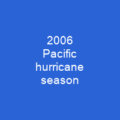The 1911 Atlantic hurricane season was relatively inactive, with only six known tropical cyclones forming in the Atlantic during the summer and fall. Three storms intensified into hurricanes, two of which attained Category 2 status on the modern-day Saffir–Simpson Hurricane Scale. Storm data is largely based on the Atlantic hurricane database, which underwent a thorough revision for the period between 1911 and 1914 in 2005.
About 1911 Atlantic hurricane season in brief

The storm was unknown until the 2005 Atlantic hurricane Database revision recognized it as a tropical storm. The hurricane database from these years is sometimes found to be incomplete or incorrect, and new storms are constantly being added to the database as part of the ongoing Atlantic Hurricane reanalysis and reassessment of the period from 1911 through 1914. The storms were identified using records including historical weather maps and ship reports, and information on the known storms was amended and corrected in the 2005 hurricane database revision and corrected. The final storm was known until the 2005 Atlantic hurricane Database revision recognized it as a tropical storm and was corrected in the 2011 hurricane database. The third hurricane of the season was the most intense storm, with a minimum central air pressure of 972 mbar. It made landfall near the border between Alabama and Florida as a small tropical cyclone. Upon making landfall, the hurricane weakened and slowly drifted westward, weakening to a tropical depression over Louisiana on August 13.
You want to know more about 1911 Atlantic hurricane season?
This page is based on the article 1911 Atlantic hurricane season published in Wikipedia (as of Nov. 04, 2020) and was automatically summarized using artificial intelligence.







